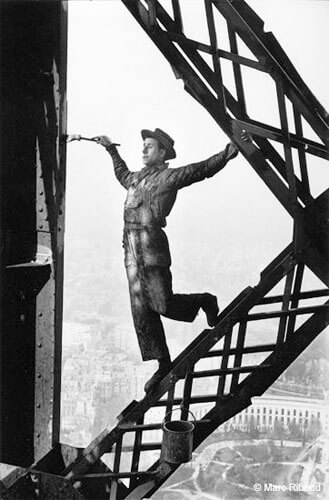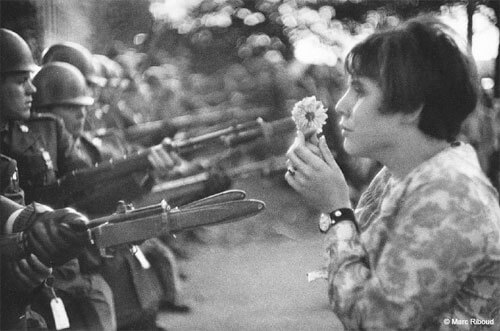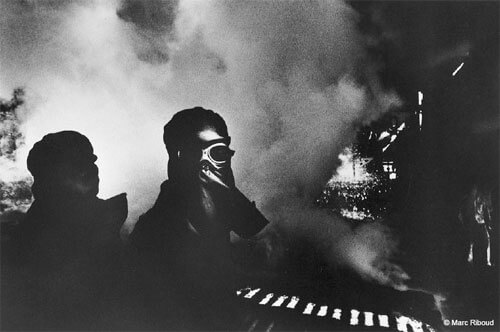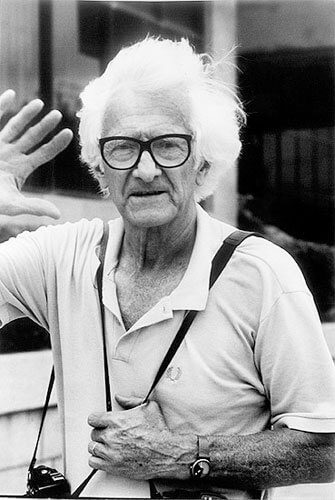Marc Riboud was a French photographer best known for his extensive reports on the Far East, including
The Three Banners of China,
Face of North Vietnam,
Visions of China, and
In China.
Photography cannot change the world, but it can show the world as it changes. -- Marc Riboud
Riboud was born in Saint-Genis-Laval and attended Lyon's lycée. He photographed his first picture in 1937, using his father's Vest Pocket Kodak camera. From 1943 to 1945, he was a member of the French Resistance as a young man during WWII. From 1945 to 1948, he studied engineering at the École Centrale de Lyon after the war.
Marc Riboud worked as an engineer in Lyon factories until 1951, when he took a week-long photography vacation that inspired him to become a photographer. He relocated to Paris, where he met the founders of
Magnum Photos,
Henri Cartier-Bresson,
Robert Capa, and
David Seymour. He was a member of the organization by 1953. His ability to capture fleeting moments in life through powerful compositions was already apparent, and he would use this skill for decades to come.

Eiffel Tower Painter, Paris, 1953
© Marc Riboud
Riboud traveled around the world for the next several decades. He was one of the first European photographers to visit China in 1957, and he documented North Vietnam in 1968, 1972, and 1976. Later in life, he traveled extensively throughout the world, primarily in Asia, Africa, the United States, and Japan.
Marc Riboud has witnessed war atrocities (photographing from both the Vietnamese and American sides of the Vietnam War) as well as the apparent degeneration of a culture suppressed from within (China during Chairman Mao Zedong's Cultural Revolution).
In contrast, he has captured the graces of everyday life in sun-drenched corners of the world (Fès, Angkor, Acapulco, Niger, Bénarès, Shaanxi), as well as the lyricism of child's play in everyday Paris. In 1976 he becomes president of Magnum and resigns three years later.
Riboud's photographs have appeared in a variety of publications, including
Life,
Geo,
National Geographic,
Paris Match, and
Stern. He has received the Overseas Press Club Award twice, the Sony World Photography Awards Lifetime Achievement Award in 2009, and major retrospective exhibitions at the Musée d'Art Moderne de la Ville de Paris and the
International Center of Photography in New York.
In 1998,
Marc Riboud was named an Honorary Fellow of the
Royal Photographic Society.
The eye is made to see and not to think.... A good photograph is a surprise. How could we plan and foresee a surprise? We just have to be ready. -- Marc Riboud
Eiffel Tower Painter, taken in Paris in 1953, is one of Riboud's most well-known photographs. It depicts a man painting the tower, posing like a dancer and perched between the tower's metal armature. Paris emerges from the photographic haze beneath him. Riboud's images frequently feature lone figures. In Ankara, a central figure is silhouetted against an industrial backdrop, whereas a man lies in a field in France. The vertical composition emphasizes the landscape, the trees, the sky, the water, and the blowing grass, which all surround but do not overpower the human element.

The Ultimate Confrontation: The Flower and the Bayonet, Washington D. C, 21 Octobre 1967
© Marc Riboud
Riboud's photograph,
The Ultimate Confrontation: The Flower and the Bayonet, taken on October 21, 1967, is one of the most famous anti-war images. The photograph was taken in Washington, D.C., where thousands of anti-war activists had gathered in front of the Pentagon to protest America's involvement in Vietnam. It shows a young girl, Jan Rose Kasmir, holding a flower and looking out at several rifle-wielding soldiers stationed to block the protesters.
Marc Riboud stated about the photograph,
"She was just talking, trying to catch the eye of the soldiers, maybe trying to have a dialogue with them. I had the feeling the soldiers were more afraid of her than she was of the bayonets."
In contrast to the images in his photo essay
A Journey to North Vietnam (1969), Riboud says in an accompanying interview,
"My impression is that the country's leaders will not allow the slightest relaxation of the population at large [...] it is almost as if [...] they are anxious to forestall the great unknown - peace." He expanded on his observations of life in North Vietnam in the same Newsweek article:
"I was astonished, for example, at the decidedly gay atmosphere in Hanoi's Reunification Park on a Sunday afternoon [...] I honestly did not have the impression they were discussing socialism or the 'American aggressors' [...] I saw quite a few patriotic posters crudely 'improved' with erotic graffiti and sketches."
Vietnam, 1976
© Marc Riboud
There is a gap between what is photographed (or published) and what Riboud said in his interview. The author
Geoffrey Wolff commented on this in 1970:
"Riboud's photographs illustrate the proposition. The French photographer has been to North Vietnam twice [...] and he is most friendly, on the evidence of his pictures, to the people and the institutions he found there. His photographs are of happy faces,[...] An Air Force ace illustrates how he shot the American 'air pirates' from the sky [...] Who knows the truth about these places?"
Rage Against the Machine, an American revolutionary political Rap Metal band, used two of Riboud's photographs for their second single
Bullet in the Head. Both images convey strong political and social messages, but they are very different. The front cover depicts American schoolchildren pledging allegiance to the 'flag' (Stars and Stripes) in a classroom; the back cover depicts a young (probably Vietnamese) boy pointing a pistol, with soldiers on parade in the background. It's unclear who or what the boy is aiming at, or if the gun is real or a toy.
Since the 1980’s
Marc Riboud keeps travelling at his own tempo. He published many books, among which the most famous are
The three banners of China,
Journal,
Huang Shan, Capital of Heaven ,
Angkor, the serenity of Buddhism,
Marc Riboud in China.
Riboud married the American sculptor
Barbara Chase, who was living in Paris at the time, in 1961. They had two kids.
Sally Hemings (1979), her debut novel, received critical acclaim and went on to become a best-seller. They divorced prior to 1981. He later married journalist and author
Catherine Chaine. Riboud died on August 30, 2016, at the age of 93, in Paris.
In 2004 his retrospective is exhibited at the
Maison Européenne de la Photographie in Paris and visited by 100 000 people. Numerous museums trough Europe, as well as United States, China and Japan regularly show his work. He received many awards, among which two Overseas Press Club, the Time-Life Achievement, the Lucie Award and the ICP Infinity Award.



